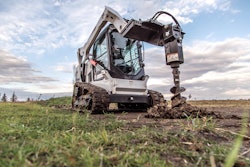
Monitoring your fleet with telematics tools is one of the best tools you can use—unless you don’t use it. And, as it turns out, most contractors aren’t doing much—or all that they could—with the technology.
That’s one of the key findings in a survey recently completed by Teletrac Navman. Even though 90 percent of the companies surveyed are using telematics, they are on average using only three out of the 12 features their systems offer.
Most contractors tee up the basics: vehicle and equipment location (73 percent), speed (55 percent), and hours of service (51 percent). But when it comes to measurements that could save them money, the participation rate is less impressive. Only 22 percent monitor engine hours and 28 percent use telematics to manage maintenance. On the business end of things, just 38 percent use their telematics to increase profits and 37 percent use it to reduce operational costs.
One of the biggest paybacks from telematics is the ability to monitor fuel use but only 21 percent of the respondents say they did that. Yet the respondents who did monitor fuel use reported an average decrease in fuel consumption of 13 percent.
So what gives guys?
According to Michael Bloom, director of product management, construction and analytics at Teletrac Navman, managers might simply be unaware of the depth of information they can extract from their telematics systems. “It’s unfortunate that customers aren’t looking at those metrics more often, because the data they generate, if used to influence decision making, could have a massive impact on the bottom line,” he says.
Time constraints are another factor, says Bloom. “Getting value out of your telematics data requires some initial time investment. Managers now have access to so much information that it can be overwhelming, and they don’t know what it all means or what actions to take,” he says.
The solution is to first figure out exactly what you should measure to further your organization’s goals. “There isn’t a one-size fits all recommendation,” says Bloom. “However the costs of not taking the time to do this will almost certain have a negative effect on the organization’s bottom line, as they miss out on significant cost savings and safety benefits.” As proof of the later, Bloom says that 51 percent of the respondents reported fewer safety incidents since adopting telematics.
Make it work for you
“The customers we’ve seen who have the most success are the ones who regularly use the telematics platform to manage their processes, analyze the information the system provides and take corrective action in the field,” says Bloom. “Telematics products have a full breadth of capabilities, and the most successful customers are the ones who use as many of those capabilities as possible.”
The managers who use telematics to its fullest advantage monitor their equipment for the right things, and “right” depends on each organization’s unique goals, says Bloom. “This brings order, insight and context to the plethora of data they see on a daily basis and helps them distill what’s useful and what can be transformed into actionable insights.”
Bloom also suggests investing in job management software that includes robust reporting capabilities. “The sheer volume of data pouring in from connected vehicles and equipment is growing all the time and it’s hard to make sense of it all,” he says. “Data on its own doesn’t automatically equal ‘information’ — it’s only useful if it’s accessible and one can derive meaningful actions to take as a result.”
You can check out the full results of Teletrac Navman’s telematics benchmark survey by clicking here.










